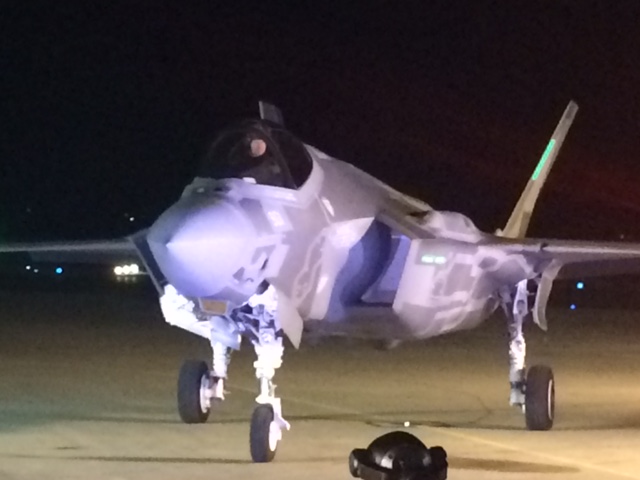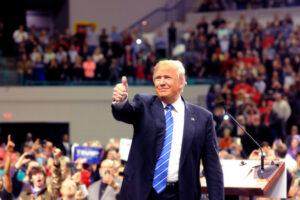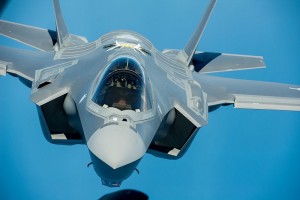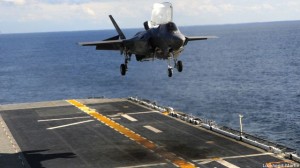Trump Vs. Pentagon: Is F-35 Really ‘Out Of Control’?
Posted on

First Israeli F-35s land at Nevatim Air Base.
WASHINGTON: Just hours after the President-Elect tweeted F-35 costs were “out of control,” sending manufacturer Lockheed Martin‘s stock price into a nosedive, the first two F-35s to be based abroad landed in their new home country, Israel. Is the famously hard-nosed Israeli Defense Force deceived about what they’re getting for their money? Or is the F-35 — being bought by the US, Israel, and at least eight other countries around the world — actually a pretty good deal?
The F-35 program and cost is out of control. Billions of dollars can and will be saved on military (and other) purchases after January 20th.
— Donald J. Trump (@realDonaldTrump) December 12, 2016
“Stating that costs are ‘out of control’ is wrong. [U]nit prices have been declining, and the program has stabilized in recent years,” wrote Byron Callan, a defense industry analyst with Capital Alpha. Sure, the program’s had problems, but they’re largely overcome, and the cost of an alternative aircraft is a huge unknown, he said. “Until the costs and risks of conceivable alternatives are known, compared to current F-35 plans, we don’t believe investors should panic over the program’s prospects based on a single Trump tweet.”
 “Another irrelevant tweet,” said Richard Aboulafia, an analyst with Teal Group. “It’s very hard to reconcile a hefty increase in defense spending with a ‘drain the swamp’ message, so tweets like these keep his base happy without any impact on funding” — or on international sales: Australia, Korea, Japan, Israel, UK, Italy, Netherlands, Norway, Denmark [are] all still buying.”
“Another irrelevant tweet,” said Richard Aboulafia, an analyst with Teal Group. “It’s very hard to reconcile a hefty increase in defense spending with a ‘drain the swamp’ message, so tweets like these keep his base happy without any impact on funding” — or on international sales: Australia, Korea, Japan, Israel, UK, Italy, Netherlands, Norway, Denmark [are] all still buying.”
Even advocates admit the F-35 has had plenty of problems. Just this year, as the Air Force’s F-35A variant first reached Initial Operational Capability (IOC), we’ve seen a grounding due to defective insulation — including in jets bound for Israel — and glitches in the high-tech jet’s millions of lines of software. (The Marine Corps’ F-35B jump jet reached IOC last year, the Navy’s F-35C carrier variant is scheduled for 2019).
[Click here to read an Air Force 3-star’s riposte to Trump: “We Need F-35s Faster, Not Fewer”]
Developmental testing is supposed to prevent such unpleasant surprises, but F-35 testing isn’t finished, which limits, for example, the number of weapons the F-35 is certified to use. There’s a reason the Pentagon’s procurement chief, Frank Kendall, said that the decision to start production on F-35 before
finishing testing was “acquisition malpractice.”

Air Force F-35A
On the other hand, building supersonic fighter jets turns out to be kind of hard — and the cost of early technical glitches was once paid not just in dollars but in lives. Even the famous F-16 was originally nicknamed “Lawn Dart” by its surviving pilots after a series of deadly crashes. Yet the F-16 program recovered and went on to be a modern icon of high performance at low cost, widely exported to US allies. It’s the F-16’s success that the F-35 program consciously sought to emulate, and compared to the F-16’s “Lawn Dart” days, F-35’s current teething troubles look pretty benign.
As for the delays and cost growth Trump referenced in his tweet, they were definitely “out of control” a decade ago — but they’re not now. In fact, the Pentagon’s imposing such tight control on the program that, when Lockheed Martin balked at the proposed terms for the next batch of F-35s, the Joint Program Office invoked a rarely-employed power to impose a price unilaterally. The cost per aircraft is dropping with every batch, down to around $100 million now and headed for $80-$85 million by 2019.
The Pentagon is now pushing for a bulk-deal “block buy” contract that it estimates could save at least $2 billion on 450 jets, though F-35 skeptic Sen. John McCain is opposed. Lockheed says it’s squeezed out $4 billion more in savings over the life of the program.
“Since the beginning, we’ve invested hundreds of millions of dollars to reduce the price of the airplane more than 70 percent,” Lockheed VP Jeff Babione said at the delivery ceremony in Israel. “We’re investing hundreds of millions of dollars to reduce the cost of sustaining the airplane over its 30-40 year lifespan.”

F-35B vertical landing
In fact, writes industry consultant and analyst Loren Thompson, Lockheed is investing so much of its own money in reducing the price of the F-35, and the government is keeping prices so low, that “Lockheed Martin has never gotten above a 9% profit margin on one of the most challenging technology projects in modern history.” For comparison, Apple’s operating margin is 39 percent.
Of course, an airplane is a boondoggle at any price if it can’t fly. Critics say the F-35 is a clumsy design with too much weight for its wings (“wing loading”) that can’t win a dogfight against the F-16, let alone cutting edge Russian and Chinese fighters. Advocates argue that the F-35 won’t let the enemy close enough to dogfight, because its stealth allows it to evade detection and its advanced sensors allow it to detect targets at long range. In exercises, F-35s have “shot down” conventional planes before the opposing pilots even knew they were there. The plane also has highly classified cyber and electronic warfare capabilities at which Pentagon officials will only hint. We do know its complex software, hard as it is to troubleshoot, is a form of artificial intelligence, able to fuse data from the plane’s own sensors, other F-35s, and other sources into a single coherent picture of the battle.
The true test of the F-35, unfortunately, won’t come until it’s used in battle. But at this stage in the program, the signs actually look pretty good.
Subscribe to our newsletter
Promotions, new products and sales. Directly to your inbox.
